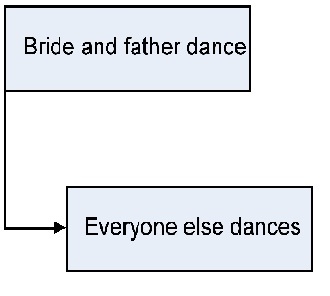41 Activity Sequencing
Activity List
Now that the activity definitions for the work packages have been completed, the next task is to complete the activity list. The project activity list is a list of everything that needs to be done to complete your project, including all the activities that must be accomplished to deliver each work package. Next you want to define the activity attributes. Here’s where the description of each activity is kept. It includes all the information you need to figure out plus the order of the work. Any predecessor activities, successor activities, or constraints should be listed in the attributes along with descriptions and any other information about resources or time that you need for planning. The three main kinds of predecessors are finish-to-start (FS), start-to-start (SS), and finish-to-finish (FF). The most common kind of predecessor is the finish-to-start. It means that one task needs to be completed before another one can start. When you think of predecessors, this is what you usually think of; one thing needs to end before the next can begin. It’s called finish-to-start because the first activity’s finish leads into the second activity’s start (Figure 10.3).
It is possible to have start-to-finish (SF) predecessors. This happens when activities require that another task be started before the successor task can finish. An example might be that the musicians cannot finish playing until the guests have started leaving the ceremony. In addition, there are some particular types of predecessors that must be considered.
External Predecessors
Sometimes your project will depend on things outside the work you’re doing. For the wedding, we are depending on the wedding party before us to be out of the reception hall in time for us to decorate. The decoration of the reception hall then depends on that as an external predecessor.
Discretionary Predecessors
These are usually process- or procedure-driven or best-practice techniques based on past experience. In the wedding example, Steve and Susan want the bridesmaids to arrive at the reception before the couple arrives. There’s no necessity; it is just a matter of preference.
Mandatory Predecessors
You can’t address an invitation that hasn’t been printed yet. So printing invitations is a mandatory predecessor for addressing them. Mandatory predecessors are the kinds that have to exist just because of the nature of the work.
Leads and Lags
Sometimes you need to give some extra time between activities. Lag time is when you purposefully put a delay between the predecessor task and the successor. For example, when the bride and her father dance, the others wait awhile before they join them (Figure 10.6).
All of the important checkpoints of your project are tracked as milestones. Some of them could be listed in your contract as requirements of successful completion; some could just be significant points in the project that you want to keep track of. The milestone list needs to let everyone know which milestones are required and which are not.
Some milestones for Susan and Steve’s wedding might be:
- Invitations sent
- Menu finalized
- Location booked
- Bridesmaids’ dresses fitted
As you figure out which activities will need to be done, you may realize that the scope needs to change. When that happens, you need to create a change request and send it through the change control system.
Some things that could go wrong:
Steve: The quartet cancelled. They had another wedding that day.
Susan: Aunt Jane is supposed to sing at the service, but after what happened at her uncle’s funeral, I think I want someone else to do it.
Steve: Should we really have a pan flute player? I’m beginning to think it might be overkill.
Susan: Apparently! Maybe we should hold off on printing the invitations until these things are worked out.
Wedding Planner: OK, let’s think about exactly how we want to do this. I think we need to be sure about how we want the service to go before we do any more printing.
The Activity Sequencing Process
Now that we know what we have to do to make the wedding a success, we need to focus on the order of the work. Sally sat down with all of the activities she had defined for the wedding and decided to figure out exactly how they needed to happen. That’s where she used the activity sequencing process.
The activity attribute list Sally created had most of the predecessors and successors necessary written in it. This is where she thought of what comes first, second, third, etc. Sally’s milestone list had major pieces of work written down, and there were a couple of changes to the scope she had discovered along the way that were approved and ready to go.
| Example milestone list: Steve and Susan had asked that the invitations be printed at least three months in advance to be sure that everyone had time to RSVP. That’s a milestone on Sally’s list. |
| Example change request: When Sally realized that Steve and Susan were going to need another limo to take the bridesmaids to the reception hall, she put that change through change control, including running everything by Susan’s mother, and it was approved. |


